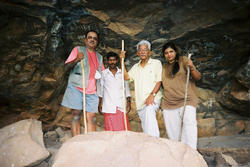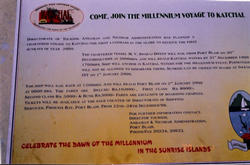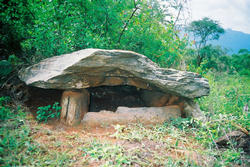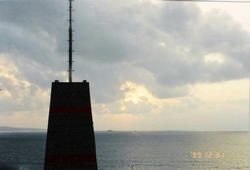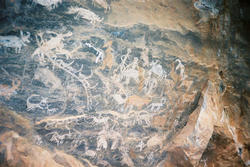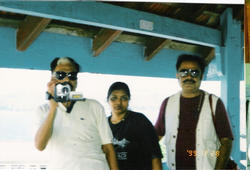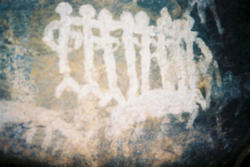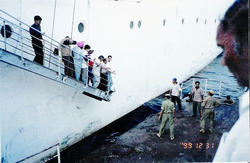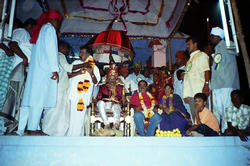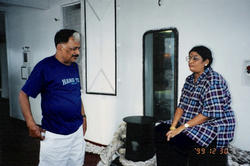EJJI'S TRAVELS
"I'm a traveler, not a tourist"
I have been fond of travel from my youngest days. My love for travel is not the touristy one. Of course, I have done most of the touristy travel in my early days. I like travel to little known or inaccessible places, when people wondering where it is, and how you got there, is comparable to the joy of seeing the place. Most would not have even heard of the places I have visited. I am sure that the District Collector in many places does not know such places exist!
“A tourist checks the weather report. A traveler just goes. I am a traveler”. Conversation closed!!!
Millenium Sunrise at Katchal Islands
Katchal, a tiny island near Nicobar was virtually unknown till the Royal Greenwich Laboratory declared that it would be the first inhabited place on earth to catch the first rays of the rising sun when it is 00hrs. 00min.00sec. on the night of 31st December 1999. That is, when the time is the perfect “midnight” between 31st December 1999 and 1st Jan. 2000. But when it is midnight at the “cross hairs” in the Greenwich Laboratory in Britain, the sun is just rising somewhere around the globe. At that precise moment when it is 00hrs.00min.00sec. in Greenwich, they calculated that Katchal would receive the first rays of the sun. And that is how most Indians and others around the world heard the name “Katchal”.
Once this announcement was made, I started finding out about Katchal and making arrangements to be there for the “Millenium Sunrise”. Katchal is a 174 sq.km. Island in the Central Nicobar Group of the Andaman & Nicobar Group of Islands. It is one of the 36 inhabited islands in the A&N Group. It is 230 nautical miles south of Port Blair. The population is around 6000 and the locals call the island Tahiya. The inhabitants are Nicobarese of Mongoloid stock, with Sri Lankan Tamil refugees working on rubber plantations brought in by the government of India. Restricted generated electricity supply and drinking water are available along with a local FM radio station, which broadcasts in Tamil, Malayalam, Nicobarese and English twice a day. The island is eco-fragile and not open to foreigners. Indians will have to be in possession of special tribal passes to visit Katchal. It has a lighthouse. It has no facilities for berthing of large ships. But very small ships can be berthed at a jetty. Local island hopping ships visit the island periodically. It has a basic government guesthouse with about 6 rooms.
The “millenium sunrise at Katchal” was widely advertised as the “Sunrise of the Millenium” by the Government of India. India’s first indigenously built modern passenger ship “Swaraj Deep” (built by the Vizag Ship Yard), was to be used for the occasion and had already been test run to Port Blair. The VIPs would include Vajpayee, L.K.Advani, Uma Bharati, George Fernandez, I.D.Swamy, Arun Jaitley, Pramod Mahajan, special invitees of the Government, a large group of foreign guests, Indian and foreign media, a VIP teenager and his Spanish-Venezuelan girlfriend. A special concert by Bismillah Khan and other top-notch artistes would welcome the millenium. Doordarshan was setting up facilities for a live broadcast of the sunrise. Advertisements appeared in a few select newspapers that tickets could be bought for the voyage to Katchal.
Once I started the process of getting the tickets, I found to my dismay that no one anywhere including the Tourism Ministry in Delhi, the Lt. Governor’s Office in Andamans, and ITDC were aware of how and where one could get the tickets. Anyway, I decided to land up at Port Blair by the 22nd of December 1999 and try my luck. In Port Blair I saw posters all over the town advertising the trip with locations where tickets would be available. I checked those locations only to find that the counters were closed 24 hours of the day! I slowly learnt that the Government of India had limited the number of “guests” for the event to 1200, being the total capacity of Swaraj Deep, but had very cleverly “hijacked” the tickets! The local Government officials in charge of this event were not willing to even issue bunker class tickets! And then luck favored me! On the evening of December 24th 1999, the Indian Airlines flight was hijacked to Kandahar. Added to it was Shankar Dayal Sharma’s death, which was followed by a 7 day mourning period, that resulted in all cultural programs being cancelled. Overnight the ticket windows opened, tickets were available, all because the VIPs had cancelled their visit! And so we got our tickets to Katchal.
The ship Swaraj Deep was a fully air conditioned liner with pile carpeting, cabins of various classes, a helipad, conference lounge, bar (kept closed as per government’s unimaginative orders), cafeterias, dining rooms etc. The ship had never been on a commercial run and was doing its first sailing with passengers.
The ship that could carry 1200 passengers was now carrying only about 290 passengers! But for about 20 paying passengers like my family, and me the rest were freeloading guests of the Government of India. There were many friends of mine who wanted to be on this epic voyage, but could not get tickets, and here was a ship sailing with empty cabins!
The ship left Port Blair at around 9.00 hrs on the morning of 30th December for a sailing of about 16 hours to reach Katchal. Around lunchtime on the 31st, we reached the waters around Katchal escorted by the ships of the Indian Navy sailing in formation beside Swaraj Deep. The sailing was smooth but for the 10 degree Channel on the way, which is considered one of the dangerous sea routes due to unpredictable currents. The Swaraj Deep was anchored in the Revello Channel a few kilometres away from Katchal. The rest of the day was spent in a series of parties, though the ship’s bar was closed. The Lt. Governor of Andamans & Nicobar and other VIPs arrived by helicopter from Port Blair in the afternoon. At night there was a fire works display from the Indian Navy ships, a dazzling spectacle of light and sound.
Midnight saw the millenium change. I had a special glass, which said “Last Drink of the 20th Century” on one side and “First Drink of the 21st Century” on the other. A round of whisky, was passed around in that glass at the stroke of midnight to welcome the 21st century much to the amusement of teetotalers and an unforgettable drink for the others!
The party continued till 4 am and we were on the various decks awaiting the millenium sunrise. The officially announced time for the sunrise was just around 5.30am. When the anxious crowd on the deck slighted the first rays of the sun bursting through the clouds, a whoop of joy and celebration reverberated through the desolate expanse of the seas heralding in a new millenium, which surely not one of those present had seen before or will ever see again! Cameras clicked. Movie cameras whirred. A religious family even conducted a full ceremony on the deck. A catholic priest chanted prayers. A honeymooning couple was in an inseparable embrace having a “millenium kiss”! A Muslim gentleman was praying facing Mecca! Everyone greeting everyone else a “Happy Millenium”. One gentleman on a self-proclaimed “mission for world peace”, was giving a speech that no one listened to. A swamiji in saffron robes conducting a blessing mela! A “gentleman who had grandly of wine” vomiting over the side into the sea! And me opening a champagne bottle (officially announced as imported non-alcoholic apple juice by the press!). It was really a moment to be treasured.
Now comes the interesting part of the story, the landing on Katchal Island. The ship is anchored miles away from the shore of Katchal as the sea is not deep enough to navigate near the island. How do you get on to Katchal?
First a word about a pontoon. A pontoon is nothing but a sheet of steel with a few rods of steel welded vertically around the sides at intervals and a plastic rope tied to the poles as a sort of boundary all round. This pontoon is towed from Katchal by a motor launch and brought near Swaraj Deep. The Swaraj Deep, though anchored well at mid sea, is swaying a wee bit from side to side and waves are crashing on its sides. The launch pushes the pontoon towards the ship and sandwiches it in between the launch and the ship. But the waves keep popping the launch and the pontoon up and down, banging the pontoon against the side of the ship.
The hydraulically operated gangway on the ship can be lowered to facilitate passengers to disembark at harbor berths. But even if you bring the gangway to its lowest position, it is about 10 feet from the pontoon surface. (Imagine that this 10 feet difference is when the pontoon is raised by an oncoming wave and pushed up towards the side of the ship where it hits the ship and falls back with the retreating wave!)
The exercise to visit Katchal is to stand at the lowest step on the gangway that has been lowered to its lowest position. Wait for the wave to push up the pontoon to bang on the ship’s side. At that very instant, jump on the pontoon surface! If you manage it without being crushed between the ship and the pontoon, you sit down on the pontoon while it moves away from the ship with the retarding wave, as it is impossible to stand up. The next wave will push the pontoon back towards the ship, and in the meantime the next person is ready at the last step of the gangway for a similar jump! When there are a few successful passengers on the pontoon, the lucky ones still alive on the pontoon walk into the safety of the launch!
It is interesting to note that not one of the ship crew was willing to try this exercise. A few of us managed to jump on to the pontoon, including a few ladies and a very old man. Sheer courage or disregard for their own lives? The launch then moves on to Katchal Island jetty. When we got off, we were welcomed by the locals and had to walk around the island.
Katchal has the local Nicobarese living in stilted houses made of thatch and wooden poles. The living quarters are in the first level and below them on the ground livestock are kept. Absolutely poor conditions. But every few hatched huts have a satellite dish wired to the other huts. You climb the rough wooden steps and go into the thatched living quarters and what do you find? Color 29” Sony TV, Nike shoes, Levi jeans, whisky and local brew, Japanese radios and music systems! How these amenities reach there is a story by itself that cannot be written for publication.
The entire landscape has coconut trees with rotting coconuts all around. Fruit trees with rotting fruit strewn and decaying on the ground. A few rubber plantations manned by Tamil refugees from Sri Lanka, settled here by the Government of India. The rest of the locals spend their time imbibing the local brew and enjoying the pleasures of life. They don’t want to even collect the naturally growing fruits and send them to the other islands or the mainland (as India is called all over A&N) for 2 reasons. Why work and earn, when everything is being doled out free by quite a few organizations? Next, the cost of transportation from Katchal to any place is prohibitive and this built in cost of transportation kills the market. They listen to music, watch satellite television, drink and while away the time. A few Ranchi Biharis and Keralites are also settled here, but carry on small trade.
After a round of the island and a good drink of the local brew with roast pork so generously offered us by the Katchal citizens, we got on to the launch for the journey back to the ship. That is when an eerie experience unfolds.
Not one of us adventuring types who accepted to visit Katchal by jumping from the ship 10 feet down to the pontoon, thought about the modalities of getting back on the ship. Yes! You can jump down 10 feet, but to get back on board the ship, you cannot fly up 10 feet! How to do it. Here’s the story.
The launch pushes the pontoon as before and sandwiches it between itself and the ship. When the wave pushes the pontoon up towards the side of the ship, you stand on the edge of the pontoon, jump up in the air and catch the ship’s lowest gangway step. If you miss, you fall into the sea, by which time the pontoon has moved away from the ship with the receding wave, and is ready to come back and crush you to death between itself and the ship!
The crew of Swaraj Deep was in readiness on the gangway and pulled up the jumping passenger by hand to safety. One old man literally slipped and fell back a few inches, but was saved by a crew member who caught his hand and hauled him up, though the old man’s jaw hit the gangway and was bleeding profusely.
The ship weighed anchor after lunch and we were on the way back to Port Blair after an experience that was unique. Unique because not one of us had been born at the turn of the last millenium. And not one of us will be alive for the next millenium sunrise. But the 21st Millenium Sunrise at Katchal was an unforgettable experience. Thanks to the Kandahar hijack and Shankar Dayal Sharma’s death, we were able to be at Katchal. And our luck prevented us from dying in our efforts to be on the pontoon.
Subsequently, the GOI started promoting Katchal as a privileged and limited tourist destination by building a couple of guesthouses. But even then they had priced it high for top end tourists, only as a package tour from Port Blair. Indians still needed a permit from the A&N Administration, and foreigners a clearance from the home ministry. Sadly the small Katchal Island was broken in two by the recent Tsunami. Nearly the entire population perished.
Go to this link for pictures of the Katchal Millenium Sunrise trip: Link for Katchal Millennium Sunrise pictures
NILGIRI ROCK ART & DOLMENS
EJJI, GUIDE, RADS & BHAMINI AT PORIVARAI CAVE
These are amateur photographs taken in Porivarai (rock art) and Masanagudi (dolmens and hero stones). Sorry if the clarity is poor. The artwork is dated anything between 4000BC and 2500 BC. Porivarai is inside the jungles and a treacherous hike through wild life territory reaches it. We are perhaps a few of the lucky ones to have been there. Absolutely inaccessible except with help of local tribes, the rock face is roughly 300ft height and 500ft long, with paintings on its eastern face. This site is one of the longest pre-historic rock art sites in Tamil Nadu. The paintings extend over a length of nearly 53mts and go up to a height of 15mts. The shelter could accommodate more than 100 people at a time, with only 2 narrow entrances. A deep valley lies below the rock, thus making it a safe and secure site. There are more than 500 images painted. The subject range from animal to human figures- a series on bulls and bull-fighting, the domestication of wild animals, deer, elephants, fowl, a man riding an animal, a man carrying animals, monkeys walking on tree branch, mongoose, monitor lizard, warriors with weapons etc. Another interesting depiction is a group of dancers with their arms thrown over the other person's waist. The dance of the local tribes is similar even today! The colors used here are ochre (red hematite) and white (lime), both available locally. The paints used were all derived from natural earth pigments, with a painting style adopted being the wet color technique. The pigments are applied straight on the rock surface. The pigments have gone straight on the rock surface, with the most commonly used material for preparing pigment in all the style periods being iron oxide, called "geru" in India. (It was pulverized and mixed with water before being applied to the rock surface. It is also likely that some binding material was used.) The natural rock wall was not prepared before the painting was done. In rock art, it is characteristic for the artist to choose to execute the work irrespective of the rock curvature or characteristics. At Porivarai, some of the representations are placed so high that they are well beyond the reach of someone standing at floor level. The Porivarai artists may either have clambered on to the wall or used an artificial aid such as vines to hang on while painting. At this site, the vast majority of recognizable representations are indeed of various species of animals and human activities. Among the animals most commonly represented are the bison, the bull and the horse. Most of the representations of humans are crude and clumsy in comparison with the many animal representations. Animals, humans or signs are shown either in isolation or on panels, which also contain several other animals, humans or signs. Another characteristic of the Porivarai panels with more than one representation on them is the frequent occurrence of super positioning. It is not at all uncommon to find one animal or sign placed on top of another or sign placed on top of another or sign either overlapping the previous representation in part only or completely covering it. Animals are almost invariably shown in profile and the varieties of stances to be found in this art are numerous. Also some images are painted with solid colors in red and white pigments; treatments believed to belong to an earlier period. The foot soldiers are armed mainly with swords and shields. The horses are draped in a fancy saddle, blankets, reins, tassels and other ornaments. Or course it is not possible to say whether there is any mythological background to these war scenes or whether they are merely a reflex icon of warfare as the artist had seen it. The detailed depictions of weapons show that the rock shelter painters were more than casually acquainted with them. It is possible that members of tribes were recruited into the royal armies and became acquainted with courtly dress and ornaments. In a few of the warrior scenes, the soldiers are standing on one base line that may indicate that they were war scenes taking place in the plains, and that may have been witnessed and recorded by the artist. The depictions of the bow are also varied. The depiction of the skeleton and intestines of living animals is a widely diffused phenomenon in the art of hunting and gathering societies. Even in the earliest paintings, depictions in the x-ray style are plentiful (see box on "X-ray expressions of pre-historic art"). The style is obviously not uniform. But uniformity is lacking even between animal depictions within the same painting group. Such x-ray style bull images are depicted in Porivarai. Similar style paintings are found mostly in central Indian rock art shelters. Such art shows the development of the artistic evolution of mankind. The depiction of the lizard in art is an ancient practice too, depicted at Porivarai in a realistic manner. However, while the purpose of its depiction is not known, it may have originated from religious/mythical practice. In general, rock art is found in/on a rock shelter/cave or dolman slabs. Early man may have used such rock art shelters as habitation sites or as a place for rest during their work in their forest. Pre-historic art gives information on pre-historic social activities, the economy, material culture, ideology and environmental context, which is often not reflected in other types of archaeological evidence. The general chronological distribution of art in the human evolutionary sequence is highly patterned; that is evidence for art, only occurs in the last 40,000 years or so. Dolmens at Masinagudi: These dolmens are inside the scrub jungle, also a wild life area, and are built on mounds of rock and rubble. The dolmens are 2 stones placed vertically with a top stone placed flat on top. This top stone looks like a frog and is sometimes referred to by the local tribes as "frog stones". All the dolmens are in a single area. Some mounds have crumbled, bringing down the stone structures. Some have survived the vagaries of nature. The age of the dolmens is anything between 2500BC and 1000BC. Hero stones at Masinagudi: These stones were erected in memory of a hero among the local tribes. Though one cannot be sure if they were also gravestones, their locations and the worship carried on to some of them even today by the local tribes, make us think that they were erected in honor of a person years ago. Some of the stone have been relocated to tribal villages from inside the forests recently. The scenes show fights by humans, sometimes on horse back and a few mythological figures. Siva lingam is also found on some, helping in dating them. I am yet to get a confirmation for the dating of these hero stones, but they are not pre-historic like the dolmens.
View more photos at hhttp://www.mediafire.com/folder/xa3ml6hw76h76/Nilgiris
ROCK ART AT PORIVARAI
Photo above is a painting in Porivarai that shows dancing girls, monkeys climbing a curved branch, x-ray paintings of animals, deer, horses, wild boar, etc.
The photo below shows a group dance by tribals. Even today the tribal dance formation is the same in the Nilgiris.
Use an imaging software and view this picture after enlarging and note the details.
TRIBAL GROUP DANCE IN ROCK ART
THE RAJAH OF SINGAMPATTI
The Rajah of Singampatti, Sri T.N.S. Murugadoss Theerthapathy is a personal friend of mine. He is the last living (surviving) crowned king of a Princely State, whose coronation took place when the British were ruling India. The reason is that his father died in 1935, and Murugaoss’ coronation was in 1936. A British regent ran the state, till Murugadoss attained the age of adulthood. A student of Trinity College, Kandy, he speaks The Queen's English and is a walking dictionary and encyclopedia combined into one. Deeply religious and interested in literature of all kinds, he is a voracious writer and has authored many books on such diverse subjects as "The History of Singampatti Royal Family" to treatises on philosophy, religion, language, Tamil literature etc.
The Rajah has always asked me to be his guest at a unique festival called the Sorimuthu Ayyyanar Temple Festival that usually takes place in August inside the Mundanthurai Tiger Reserve, near Singampatti. Shyamala and I, joined by a good friend Radhakrishnan attended it in 2005.
This festival attracts nearly 4 lakhs people. The temple is situated inside a protected Tiger Reserve, but for this annual festival, all rules of the land, especially those that govern entry into reserved forestland and its use, are forgotten. Governments do not want to disturb a tradition of many centuries, since these 4 lakh visitors to the temple constitute a very important vote bank. People come in droves and shack up at all places. The river that runs through the place as well as the surrounding forests are filled with people, cooking fires, domestic animals, vehicles of all sorts, and of course a sea of human urine and excrement. A carnival atmosphere prevails with all types of carnival shops that have been erected.
The temple itself is a very simple single roomed affair. The Rajah by tradition has a small house opposite the temple inside the same compound with 3 rooms, each 10feet x 6feet. Only 2 of the rooms have an Indian style toilet. Only one of the rooms has a simple modification over the Indian style toilet to convert it into a sitting potty. Ever meticulous in his planning, the Rajah had given me this last room!!
There is no privacy in these rooms as people keep coming in droves to meet and seek the blessings of the Rajah and give him gifts, which he reciprocates in good measure. The festival is on for 4 days and 4 nights. On the semi-ultimate night, the Rajah of Singampatti gives audience to his folk, sitting on a throne with all the royal ornaments and regalia. There is an entertainment program and some of the traditional temple entertainers have always been given the palace and temple jewels to wear. Most of the entertainers and the devotees are pissed out with local and bottled liquor. They come and see the Rajah in the public audience. Around 9 pm there is fire walking in the courtyard. After midnight a few hundred goats are slaughtered in the same courtyard beside the polluted, excrement filled river.
We stayed there only for two nights, but it is the pinnacle of our travels and we are all greatly indebted to our good friend Sri Murugadoss Theerthapathy, The Rajah of Simgampatti for seating us with him during the royal audience.
THE RAJAH OF SINGAMPATTI WITH EJJI & SHYAMALA AT DURBAR
